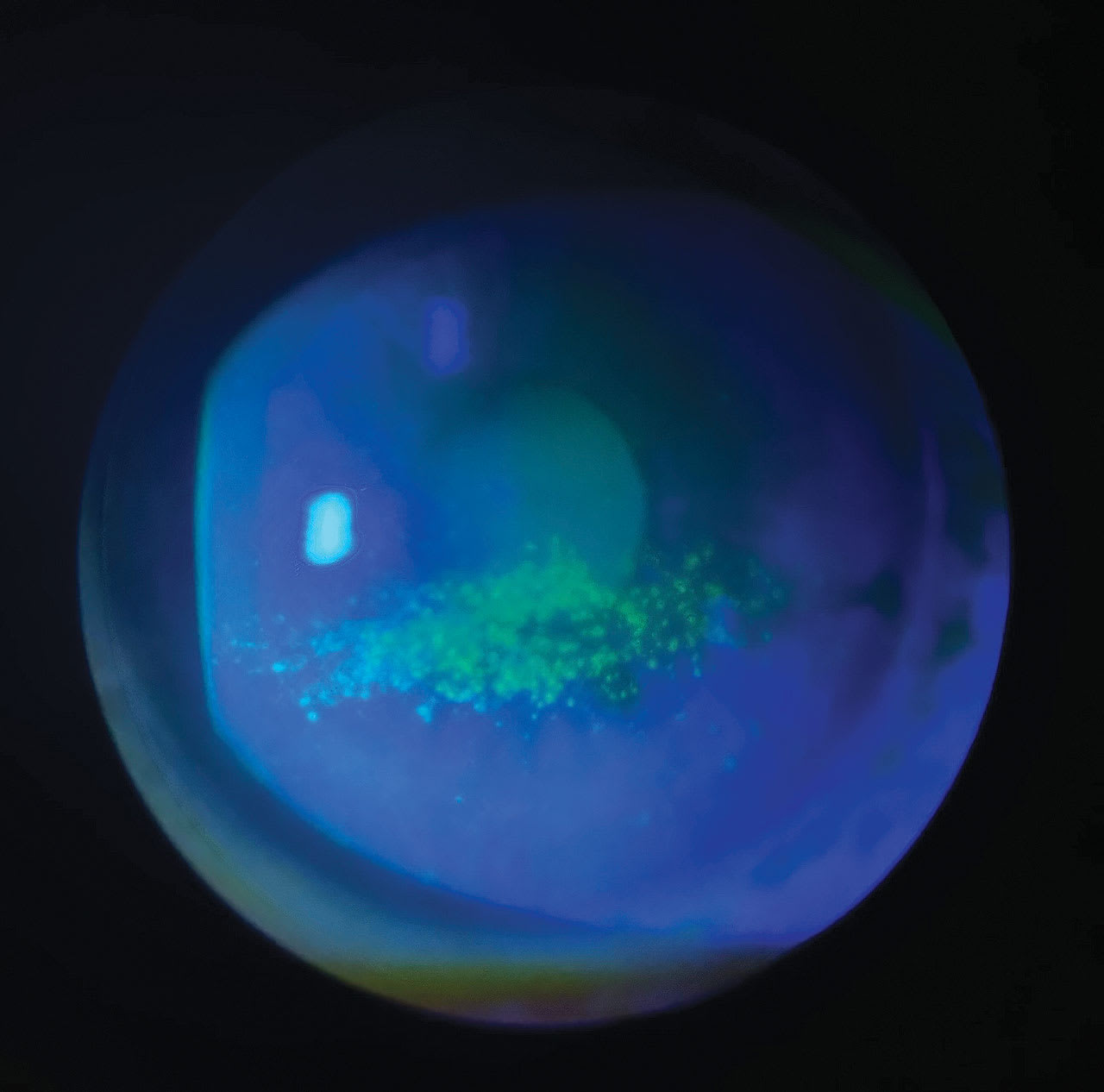Multiple intravitreal antivascular endothelial growth factor (anti-VEGF) injections have preserved sight in many age-related macular degeneration (AMD) and diabetic macular edema (DME) patients. Their repeated use can cause negative corneal changes. Thus, we must be aware of the studies that show this, the effect these negative changes have, and how to manage these patients.
Studies
Measuring the corneal nerves of patients treated with anti-VEGF injections for AMD and DME reveal: • Corneal nerve fiber density, corneal nerve branch density, and the total length of all nerve fibers were significantly reduced by the third intravitreal injection.1,2
• A significant decrease in corneal sensitivity, as well as an increase in Ocular Surface Disease Index symptom scores by the third intravitreal injection.2
• The corneal measurements of treated AMD vs DME patients did not differ.2

Effect
When corneal nerves are damaged, they are unable to signal the brain for support, which increases the risks for nonhealing, persistent epithelial defects known as neurotrophic keratitis (NK).2 In patients who have diabetes, in particular, anti-VEGF injections can exacerbate pre-existing neuropathy and hinder wound healing.3
Management
We should have these patients use osmoprotective preservative-free artificial tears to protect the ocular surface’s microenvironment after injection.1
Further, given the studies discussed above, we should screen for NK in our AMD and DME patients.4 Corneal sensation testing can be assessed using a Cochet-Bonnet aesthesiometer, dental floss, a cotton wisp, or a noncontact esthesiometer. Taking an inside-to-outside approach to NK, I recommend prescribing Omega-3 polyunsaturated fatty acid supplementation (inside), preservative-free artificial tears, neuromodulators, steroids, autologous serum tears or bandage contact lenses, amniotic membranes, punctal plugs, and cenegermin-bkb 0.002% 20 mcg/mL (Oxervate, Dompé) (outside).
Oral Omega-3 polyunsaturated fatty acid (n-3 PUFA) supplementation can improve corneal nerve density and tear function in patients who have diabetes.5 Improving corneal nerve health also decreases tear osmolarity and betters dry eye symptom scores.6 Further, Omega-3 supplementation is shown to increase both the length of corneal nerves and branch density in 90 days.7
Corneal wound healing has been shown to be enhanced by curcumin. Based on in vitro cell studies, curcumin has been shown to downregulate pro-inflammatory cytokines in the conjunctiva. However, clinical research on this specific effect in humans is limited.8 These are both great reasons to supplement curcumin in patients at risk for developing diabetic keratopathy.
Keeping Tabs
For patients who need repeated anti-VEGF injections, especially for DME, we should pay attention to changes affecting the corneal nerves. Additionally, we should monitor for NK in DME patients who have a history of extensive panretinal photocoagulation laser treatment, which damages the ciliary nerves and, ultimately, the corneal nerves.
Finally, supporting patients from the inside and the outside with the above-mentioned interventions aids in the recovery of patients who have NK. OM
References
1. Qi Y, Cui L, Zhang L, et al. Effect of repeated intravitreal anti-vascular endothelial growth factor drugs on corneal nerves. Medicine (Baltimore). 2023;102(29):e34210. doi:10.1097/MD.0000000000034210.
2. Polat OA, Şener H, Erkiliç K. Corneal Nerve Fiber and Sensitivity Loss After Repeated Intravitreal Anti-VEGF Injections: An In Vivo Confocal Microscopy Study. Cornea. 2022;41(3):317-321. doi:10.1097/ICO.0000000000002836.
3. American Diabetes Association Professional Practice Committee. 12. Retinopathy, Neuropathy, and Foot Care: Standards of Care in Diabetes-2025. Diabetes Care. 2025;48(1 Suppl 1):S252-S265. doi:10.2337/dc25-S0124.
4. Gurnani B, Feroze KB, Patel BC. Neurotrophic Keratitis. In: StatPearls. Treasure Island (FL): StatPearls Publishing; March 27, 2025.
5. Deinema LA, Vingrys AJ, Wong CY, Jackson DC, Chinnery HR, Downie LE. A Randomized, Double-Masked, Placebo-Controlled Clinical Trial of Two Forms of Omega-3 Supplements for Treating Dry Eye Disease. Ophthalmology. 2017;124(1):43-52. doi:10.1016/j.ophtha.2016.09.023.
6. Britten-Jones AC, Kamel JT, Roberts LJ, et al. Investigating the Neuroprotective Effect of Oral Omega-3 Fatty Acid Supplementation in Type 1 Diabetes (nPROOFS1): A Randomized Placebo-Controlled Trial. Diabetes. 2021;70(8):1794-1806. doi:10.2337/db21-0136
7. Chinnery HR, Naranjo Golborne C, Downie LE. Omega-3 supplementation is neuroprotective to corneal nerves in dry eye disease: a pilot study. Ophthalmic Physiol Opt. 2017;37(4):473-481. doi:10.1111/opo.12365.
8. Liu XF, Hao JL, Xie T, Mukhtar NJ, Zhang W, Malik TH, Lu CW, Zhou DD. Curcumin, A Potential Therapeutic Candidate for Anterior Segment Eye Diseases: A Review. Front Pharmacol. 2017 Feb 14;8:66. doi: 10.3389/fphar.2017.00066.




